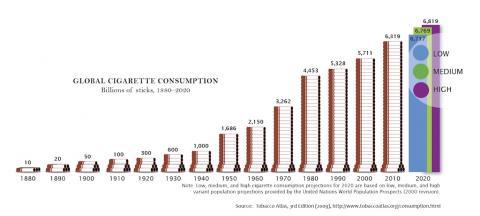

There is often a perception that academic research is divorced from policy. In many instances that is true, and it is unfortunate. Policy-oriented research that does not reach the eyes of policy makers is largely wasted. The challenge for researchers is to make the research accessible to policy makers. As researchers are typically not very good at promoting their work, it is fortunate that there are lobby or interest groups that specialise in this area. In the case of tobacco control, that role has traditionally been played by the National Council Against Smoking, and, more recently, also by the TAG Tobacco Alcohol and Gambling Advisory Advocacy and Action Group.
In 1996 I published a paper in the South African Journal of Economics, titled “Excise taxes on tobacco: How much scope does the government have?” I was a junior lecturer at the University of Stellenbosch at the time and the head of department expected me to do research and to publish, much as is the case today. I had no intention of specialising in the economics of tobacco control. I simply wanted to get a paper published and please the head of the department. My involvement in tobacco control research was not something that I had planned, but resulted from a fortuitous and somewhat random event.
In 1994 the Industrial Development Corporation published a book with time series data on price and output indices for 30 different industries. Back then, publicly available datasets were scarce. I thought that it would be interesting to estimate the price and income elasticities of demand for the products made by these 30 industries. It turned out that the data did not play along at all. For most industries the estimated elasticities were either of the wrong sign (i.e. positive price elasticities, suggesting a positively-sloped demand curve or negative income elasticities, suggesting that the product is inferior), or statistically insignificant. No journal would publish such results. For only one industry did the regression equations worked out beautifully: tobacco.
Both the estimated price elasticity (around -0.6) and the income elasticity were in line with economic theory. Based on these results I decided to focus my article around a topic that was very relevant at the time, namely, if the government were to increase the excise tax, what would be the likely consequences in terms of revenue generation and tobacco consumption? The Minister of Finance in the newly-elected democratic government under President Mandela had announced in June 1994 that he wished to increase the excise tax on tobacco products to 50% of the retail price, up from the 20% tax burden at that point.
In the paper I estimated that the government would maximise its revenue if it set the excise tax at 110% of the “producer” price. Together with VAT, that would have implied a total tax burden of 52% of the retail price. I estimated that, if the government were to set the excise tax at this level, the government could expect to (at least) double its tobacco excise revenues and that consumption would drop by between 41% and 46%. I also predicted that the real retail price would rise by between 44% and 122% from their 1989 levels.
The Minister of Finance announced the government’s plan a few months before I presented my initial results at an economics conference in November 1994. After the conference the National Council Against Smoking contacted me and asked for the report. I was told much later that they used the report to lobby the government to keep to its commitment of raising the excise tax.
In hindsight, it is possible to evaluate the accuracy of the predictions I made in the 1996 paper. I did not attach a time dimension to the analysis in the 1996 paper, but let’s look at what happened over the subsequent ten years. The government stuck to its 1994 commitment and substantially increased the total tax burden during the late 1990s and early 2000s.
It turns out that the predictions were quite accurate. Between 1994 and 2004 real government revenue increased by 140%, even more than the doubling that was predicted. Aggregate cigarette consumption decreased by 31% and per capita consumption decreased by 44%, exactly in line with predictions. The real retail price was 142% higher than in 1989, which was more than predicted (44% −122%), primarily because the tobacco industry was “overshifting” the tax increase, i.e. raising the retail price by more than the increase in the excise tax. This was something I had not foreseen when I did the analysis in 1994.
As forecasts go, the predictions that I published in the 1996 paper in the South African Journal of Economicswere reliable. But other than being a source of some pride, they illustrate a very important principle, namely that the demand for tobacco is highly predictable. While this was particularly true for South Africa, it has been found to be true in most countries where the demand for tobacco products has been estimated econometrically.
The implication is that an increase in the retail price, caused by an increase in the excise tax, will have predictable consequences for tobacco consumption and government revenue. In nearly all countries the price elasticity of demand for tobacco falls in the inelastic range. An increase in the excise tax increases the retail price, which decreases cigarette consumption, but also increases government revenue. Models like the WHO’s TaxSim and the Knowledge Hub’s TetSim, allow the likely consequences of such a tax change to be quantified.
One key aspect of excise tax modelling is that all other factors remain constant. For example, if consumers can switch to cheap, illicit cigarettes, in response to higher cigarette prices, it becomes difficult to make accurate predictions. This is why it is important that governments focus on all aspects of tobacco control at the same time. Since South Africa did not have an illicit trade problem in the 1990s and 2000s, I was able to accurately predict the consequences of a tax change. However, if the illicit market is growing, as it has been in South Africa in the past number of years, the relationship between cigarette consumption, taxes and prices break down, and the predictability of the tax changes is undermined.





